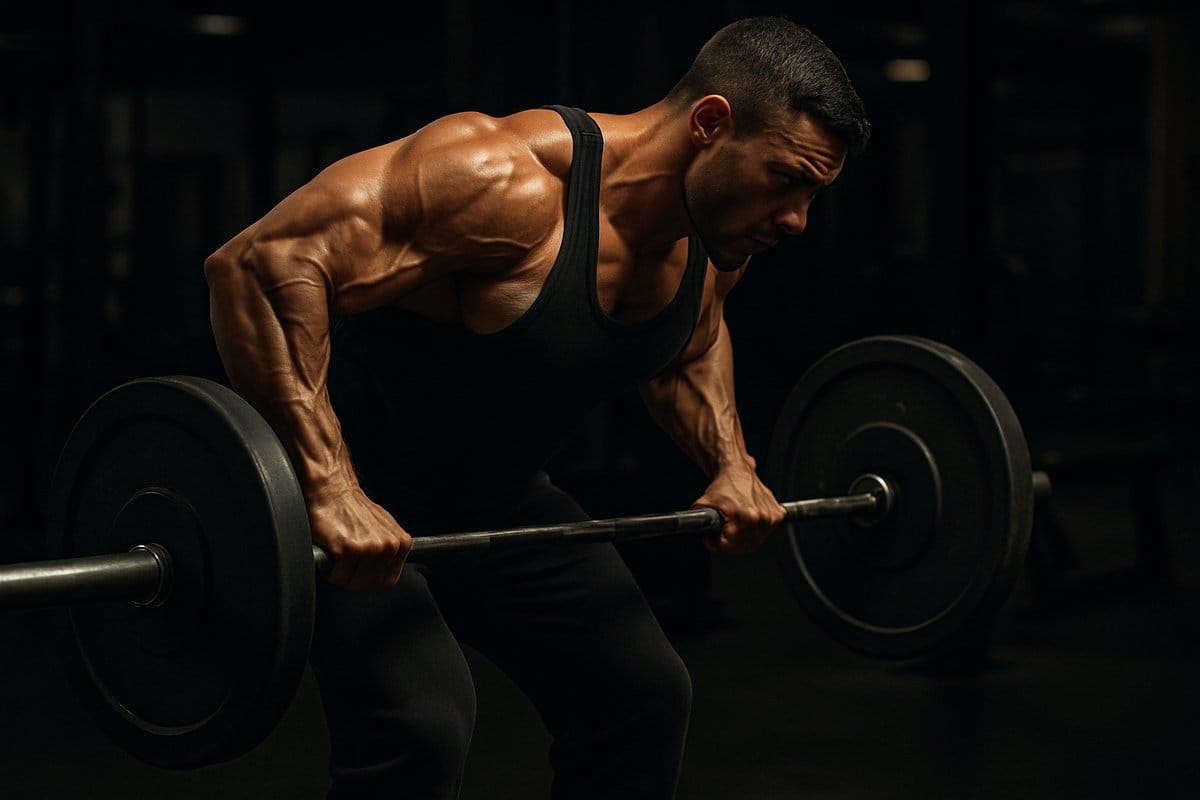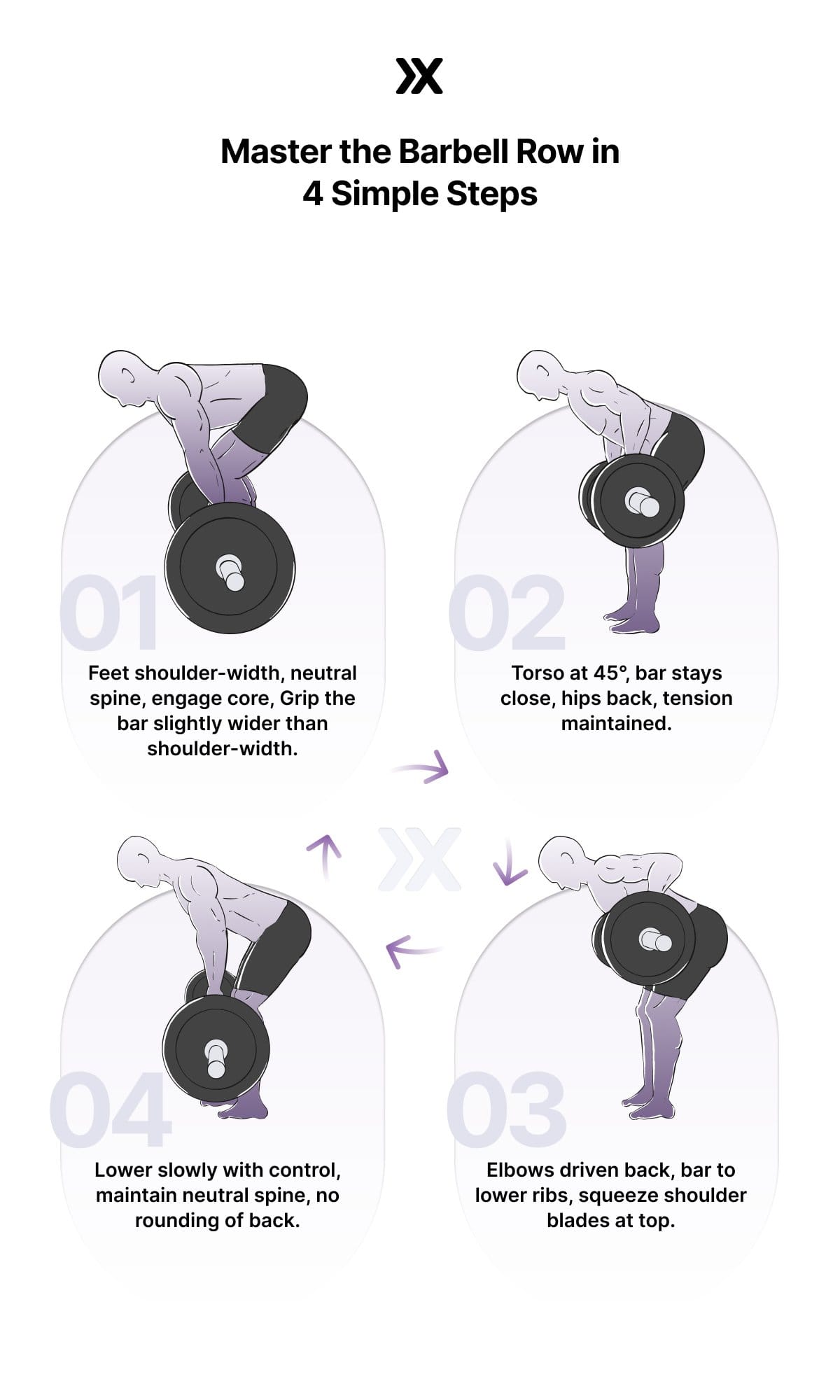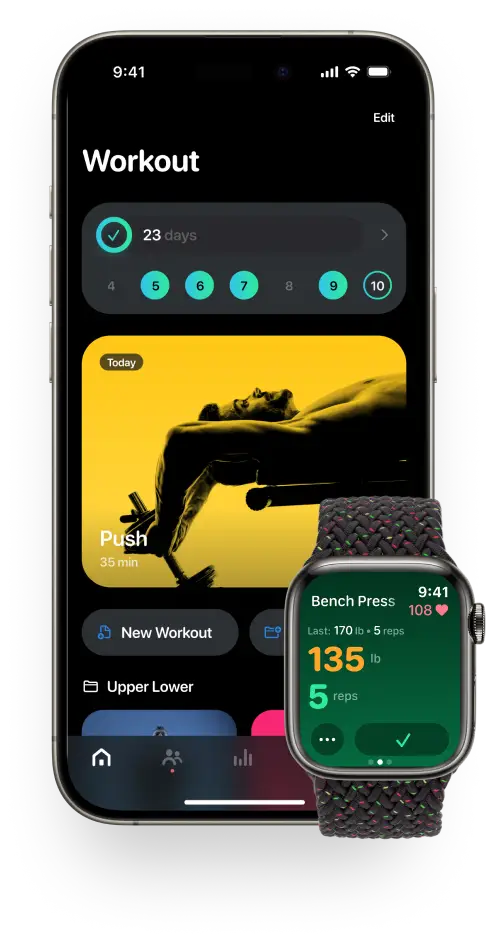How to Barbell Row: Form, Benefits & Tips
Learn how to barbell row with proper form, avoid common mistakes, and build a stronger back. Follow this step-by-step guide for maximum results.
Big backs: Every serious weightlifter wants them, but how can you achieve them? Enter the barbell row, a compound back exercise that is great at building that thick and strong back people dream of.
But how does one perform the barbell row? What equipment is necessary? What are the main benefits and mistakes one needs to watch out for? That’s what this article is all about. Let’s learn how to barbell row with proper form and master this killer exercise!

Why the Barbell Row is Essential
The barbell row is an exercise that consists of pulling a barbell toward your chest, simulating a rowing motion, hence the name. It engages the back, shoulders, and arms and is particularly good at improving posture, increasing pulling power, and building a thicker, more muscular back. If any of those are part of your gym goals, this compound exercise fits right into your workout routine.
Key Benefits of the Barbell Row
- Builds a Stronger Back – The main back muscles this exercise engages are the latissimus dorsi, traps, and rhomboids which are all key muscles to develop in a strong and good-looking back.
- Improves Posture – The barbell row strengthens the posterior chain, which helps counteract the negative effects of the prolonged sitting hours we face everyday.
- Enhances Pulling Strength – Is your grip strength preventing you from evolving on exercises like the deadlift or the pull-up? The barbell row can help you develop that grip and arm strength.
- Supports Athletic Performance – If you practice any sport that requires explosive pulling power, such as wrestling and, of course, rowing, then this exercise is of great benefit to you.

Step-by-Step Instructions: How to Barbell Row with Proper Form
Hopefully, it’s already clear why the barbell row is a must-have in any serious training program. However, bad form kills gains and puts your lower back at risk. Here’s how barbell roll perfectly for maximum muscle activation and strength gains.
Step 1: Setup – Nail Your Starting Position
- Foot Placement: Stand with your feet shoulder-width apart and the barbell over the middle of your foot.
- Grip: Use an overhand grip (palms down), slightly wider than shoulder-width.
- Hinge & Position: Bend at the hips, pushing your butt back while maintaining a neutral spine (no rounding).
- Knee Slightly Bent: Avoid locking your knees; this keeps tension on your posterior chain.
- Engage Your Core: Brace your abs as if you're about to get punched. This takes the load off your lower back.
Pro Tip: A mixed grip (one palm up, one down) can help with grip strength, but it’s not necessary unless you're pulling heavy.
Step 2: Lift-Off – Get into the Starting Position
- Lift the bar off the ground by pushing through your legs and bringing your torso to a 45-degree angle.
- Keep the bar close to your body. Be careful because letting it drift forward shifts stress to your lower back.
- Your shoulders should be slightly in front of the bar to maintain optimal pulling mechanics.
Why This Matters: A bad setup leads to poor execution and injuries. Get the form down before increasing weight!
Step 3: The Row – Pull with Power
- Drive your elbows back, pulling the bar toward your lower ribcage (not your chest!).
- Squeeze your shoulder blades together at the top for max contraction.
- Keep your torso still: if you're jerking the weight, it's too heavy!
Pro Tip: Think about pulling with your elbows, not your hands—this helps engage your lats properly.
Step 4: Lower with Control
- Slowly lower the bar back down, keeping tension on your back muscles.
- Maintain your hip hinge position, don’t let that back round!
- Reset and prepare for the next rep.
Why This Matters: Controlled negatives increase time under tension, leading to better muscle growth.

Common Mistakes to Avoid
Poor execution during the barbell row is a one-way ticket to lower back strain, inefficient muscle activation, and stalled progress. To help you out, here are the most common mistakes lifters make and how to fix them.
1. Rounding the Lower Back
Mistake: Letting your back round under heavy weight places excessive stress on the spine.
Fix: Keep a neutral spine by engaging your core and maintaining a proper hip hinge. If you can’t, lower the weight.
2. Using Momentum Instead of Muscle
Mistake: Jerking the bar up with your hips or bouncing the weight removes all the tension from your back and is going to get you injured.
Fix: Slow down and focus on controlled reps. If you can’t pull the weight without swinging, it's probably too heavy.
3. Pulling Too High or Too Low
Mistake: Rowing the bar to your chest turns it into a biceps movement while pulling too low (toward the hips) shifts tension away from your upper back.
Fix: Aim for your lower ribcage or upper abs to maximize lat and trap activation.
4. Letting the Elbows Flare Too Wide
Mistake: Allowing your elbows to flare at 90º shifts tension away from the lats and is sure to get you a shoulder strain eventually.
Fix: Keep your elbows at around a 45º / 60º degree angle to stay in the best pulling position.
Avoiding these mistakes ensures that every rep is effective, safe, and working towards real progress. Trust us, quality execution beats heavy, sloppy reps every time.

Tips for Maximizing Results
Perfect form is just the foundation. To get the most out of your barbell rows, focus on progressive overload, optimal recovery, and intelligent programming. Lets break it down:
1. Increase Weight Strategically
Progressive overload is key to muscle growth. Weightlifting doesn’t get easier, you just get stronger. You need to keep increasing weight as your body adapts to it. A good rule of thumb is: if you can perform more than 10-12 perfect reps, it’s time to go heavier.
2. Train with the Right Frequency
It will depend on your program, but barbell rows can be performed 1-3 times per week. Pair them with deadlifts, pull-ups, and lat pulldowns for a complete back workout.
3. Use Lifting Straps When Necessary
Grip fatigue can limit back activation. If your forearms give out before your back, lifting straps can help you push past that barrier. However, it’s important not to rely too much on them; work those forearms!
4. Experiment with Grip Variations
- Overhand grip (standard): Emphasizes upper back and traps.
- Underhand grip (reverse row): Involves more biceps and lower lats.
- Wider grip: Targets rear delts and upper traps.
Small adjustments in grip can shift muscle activation and keep your training progressive and effective.
Frequently Asked Questions (FAQs)
Is the Barbell Row Better Than the Dumbbell Row?
Both exercises are incredible and have their place in a workout routine: Barbell rows allow for heavier loading and greater overall strength development. At the same time, dumbbell rows provide a greater range of motion and unilateral balance. A well-rounded program can and should include both.
Should I do barbell rows before or after deadlifts?
It’s all about fatigue and focus. If deadlifts are your priority, do them first to maximize strength. If you want to emphasize your back, starting with barbell rows ensures those muscles are fresh. Usually, it's best to do the barbell rows after the deadlifts or on a separate day since deadlifts can demand the most out of your body.
Can Barbell Rows Replace Deadlifts?
No, different exercises and muscles targeted. While both target the posterior chain, deadlifts involve more hip and hamstring activation, while barbell rows focus on upper and mid-back development. They sure complement each other but aren’t interchangeable.
Can I do barbell rows with a Smith machine?
Yes! The Smith machine is awesome and can be a great option if you are just starting with barbell rows or want to try some heavier weights. However, keep in mind that the Smith machine limits the natural movement path and reduces the stability challenge. This means the traditional barbell row is better for overall muscle engagement.
What’s the best way to warm up for barbell rows?
You can activate your upper back with band pull-apart or face pulls. But the best way to warm up for this exercise is to do warm-up sets with less weight so your muscles get ready for the challenge at hand.
https://www.shutterstock.com/pt/image-photo/shot-muscular-young-woman-doing-row-2063721683 (A fit woman in a black sports bra and gray leggings performs a bent-over barbell row in a dimly lit gym, her muscles engaged under warm lighting.)
The Takeaway
Getting the barbell row right isn’t just about lifting: it’s about executing every rep with focus and intent. Keep your core tight, your movements controlled, and progressively overload to see real gains!
Ready to conquer the body of a Greek god? We’ve made it simple to work on customized fitness plans or to introduce a little friendly competition to your fitness community by sharing exercises with your friends. Get started for free through the Flex fitness app.
Related articles


Get fit with Flex
Build muscle & lose weight fast for free.
Available on iPhone + Apple Watch





